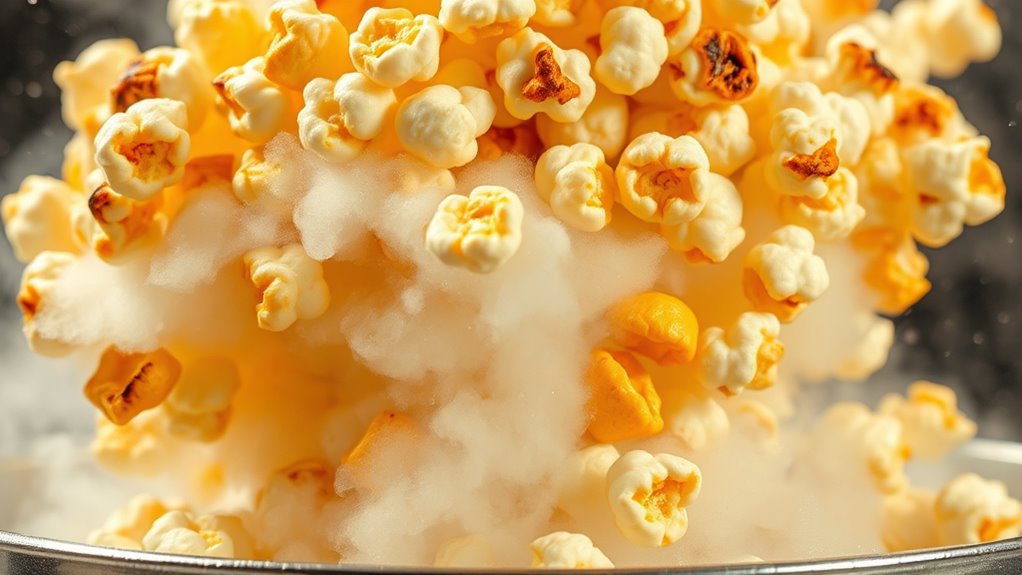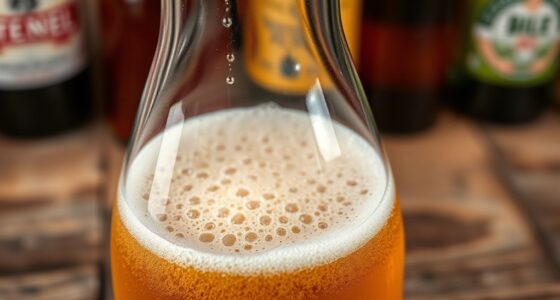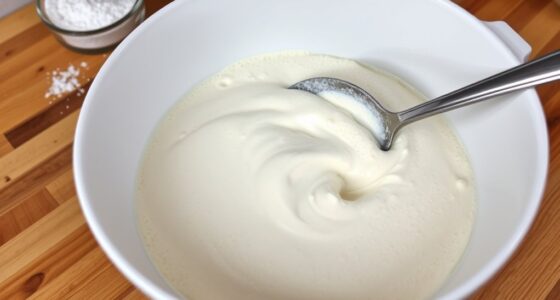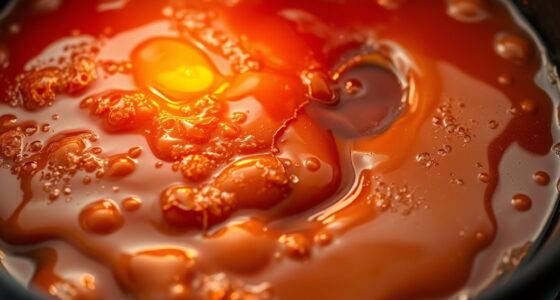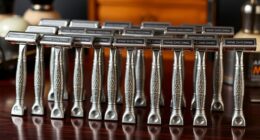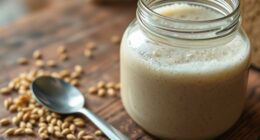When popcorn heats, the moisture inside turns into steam, building pressure against the tough shell. Once it reaches about 180°C, the pressure exceeds the hull’s strength, causing it to rupture suddenly. This releases heat that gelatinizes the starch, making it expand into the fluffy popcorn we enjoy. During this process, the starch’s molecular structure changes physically, while flavor develops through browning. Keep exploring to understand how these complex reactions make popcorn pop so perfectly.
Key Takeaways
- Heat causes internal moisture to vaporize into steam, building pressure until the pericarp ruptures.
- Starch gelatinizes and expands rapidly during popping, creating the fluffy, expanded popcorn structure.
- The pericarp’s strength and kernel moisture content determine popping efficiency and final texture.
- Molecular bonds within starch break and reform, enabling physical transformation without significant chemical change.
- Flavor and aroma develop through Maillard reactions and caramelization during heating, influencing popcorn’s taste profile.
The Basic Components of Popcorn Kernels

The basic components of popcorn kernels include the endosperm, pericarp (hull), germ, and moisture.
The endosperm makes up most of the kernel’s volume and weight, consisting of soft and hard starch granules that store energy. When heated, these starches gelatinize and expand, creating the fluffy interior of popped popcorn. The gelatinization process is crucial for the texture of the finished product, and precise heat control can help optimize it. Proper heat distribution can influence how evenly the starches gelatinize and expand, resulting in a better popcorn texture.
The endosperm’s starches expand and gelatinize, forming the fluffy popcorn interior.
The pericarp is the tough outer shell made of cellulose, acting as a moisture barrier and withstanding internal pressure up to about 135 psi before bursting.
The germ is the tiny core containing oils, nutrients, and genetic material essential for seed growth, influencing flavor and texture. Moisture, about 13.5-14%, is stored within the endosperm’s starch, turning to steam during heating. Attention in creative practice can help improve the precision of heat application during popping, ensuring consistent results.
Together, these components determine how popcorn pops and the quality of the final product.
How Heat Triggers the Popping Process
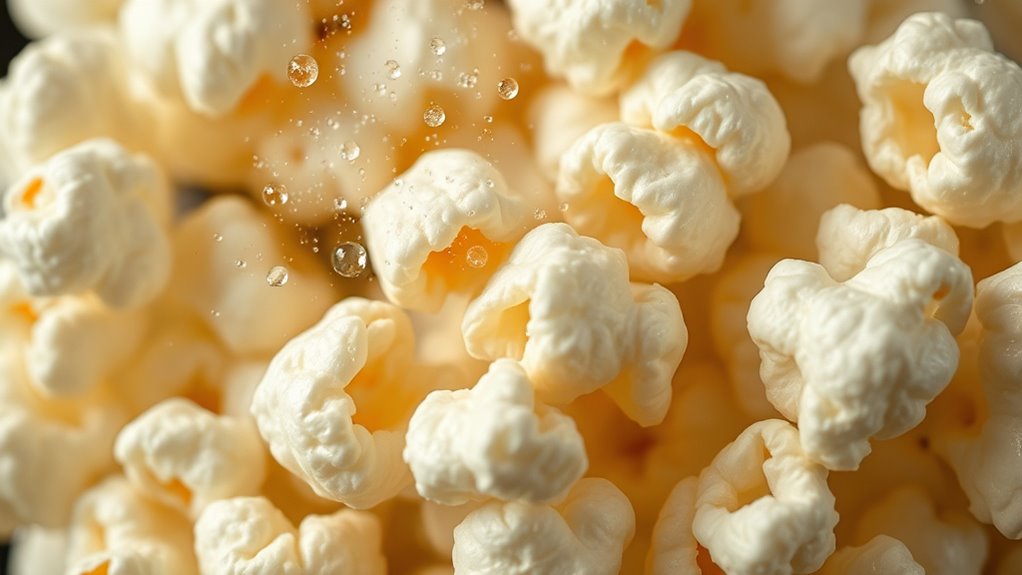
How does heat actually cause popcorn to pop? When you heat the kernel, heat transfers mainly through direct contact with a hot surface, like a pan or microwave walls. This causes the moisture inside the kernel to vaporize into steam. As temperature rises, pressure builds inside the pericarp, or hull, until it reaches about 135 PSI. Once it hits roughly 180°C (356°F), the internal pressure overcomes the hull’s strength, causing it to rupture. This rapid release of pressure causes the starch inside to gelatinize, then quickly expand and solidify into popcorn’s airy texture. Uniform heating ensures most kernels reach this critical temperature simultaneously, maximizing popping efficiency and producing fluffy popcorn. Proper heating methods, such as using a consistent heat source, help achieve optimal popping conditions, and incorporating evenly distributed heat can further improve the popping performance and overall texture of the popcorn. Additionally, understanding heat transfer mechanisms can help in designing better popcorn popping techniques.
Chemical Changes During Popping
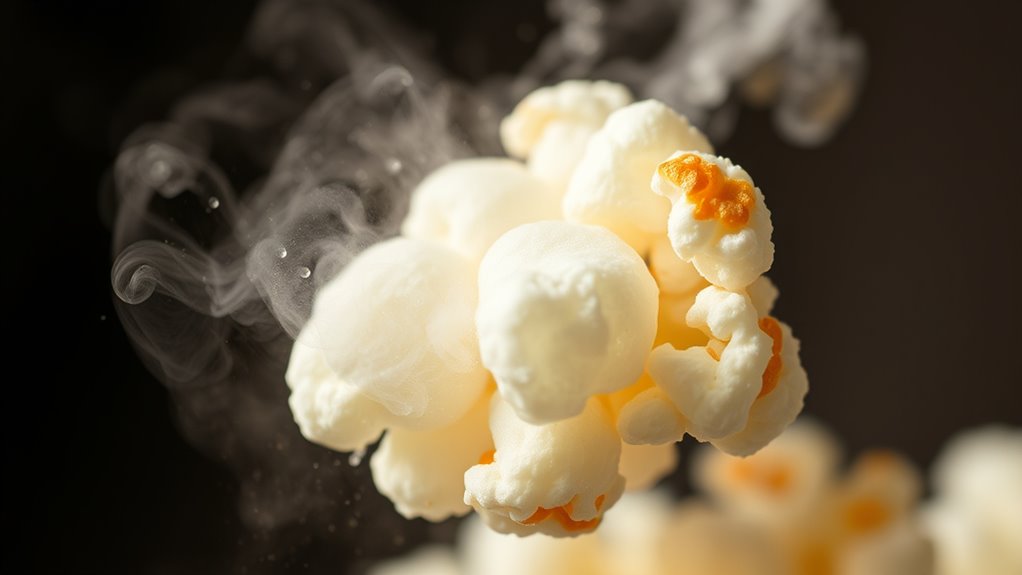
When heat causes the moisture inside a popcorn kernel to vaporize, it sets off a series of chemical changes within the starch and protein components. The high temperature causes starch granules to absorb water, swell, and gelatinize, altering their molecular structure. This process is a combination of physical and chemical changes, as hydrogen bonds break and reform, making starch more amorphous and viscous.
Proteins and lipids mostly remain intact but may undergo minor denaturation. Surface reactions like Maillard browning and caramelization can produce flavor and aroma changes but don’t create new compounds internally. As pressure builds, the gelatinized starch expands rapidly when the hull ruptures, then cools and retrogrades, stabilizing the fluffy texture through molecular reassociation. These chemical transformations underpin the popcorn’s final structure and flavor. Additionally, food chemistry principles help explain how these molecular changes contribute to the unique texture and taste of popped popcorn.
Physical Transformations Inside the Kernel
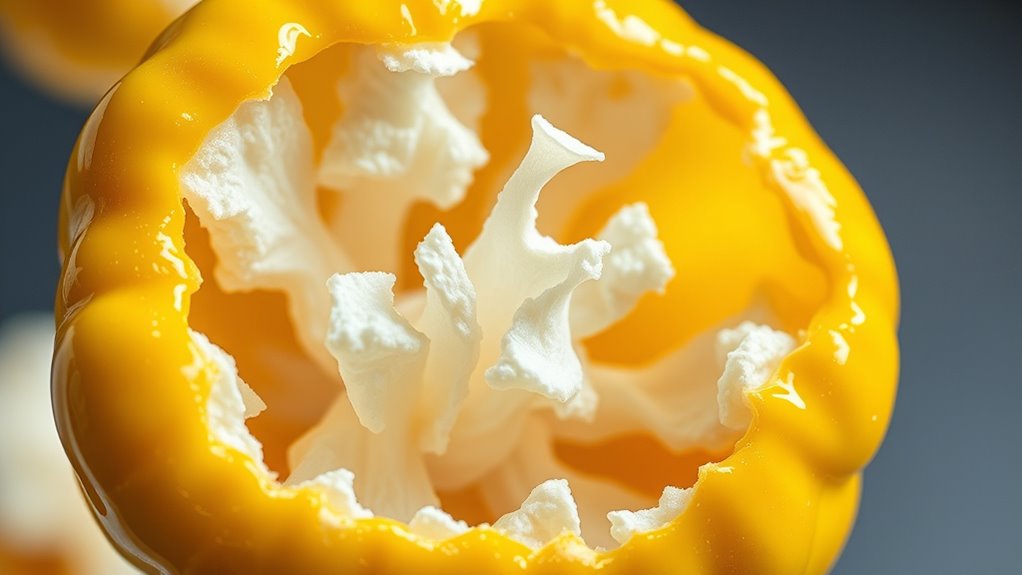
As heat causes moisture inside a popcorn kernel to vaporize, pressure builds rapidly until the hull can no longer contain it. The hull’s tensile strength sets the limit for internal pressure, and once it fails, the kernel ruptures explosively. This sudden burst releases steam and gelatinized starch, transforming the dense kernel into fluffy popcorn. The vaporization of water creates the necessary internal pressure, while the rapid expansion of starch forms the characteristic white structure. During popping, the kernel’s shape changes from smooth and hard to irregular and spongy. High-speed cameras reveal that kernels may jump or spin slightly, propelled by the mechanical energy stored in the starch “leg.” These physical transformations are driven by pressure, heat, and rapid expansion, fundamentally altering the kernel’s shape and density. Additionally, the process is influenced by the material properties of the hull, which determine how much pressure it can withstand before rupturing. The material composition of the hull is crucial in defining the kernel’s popping behavior and final texture.
Key Variables Influencing Popcorn Expansion
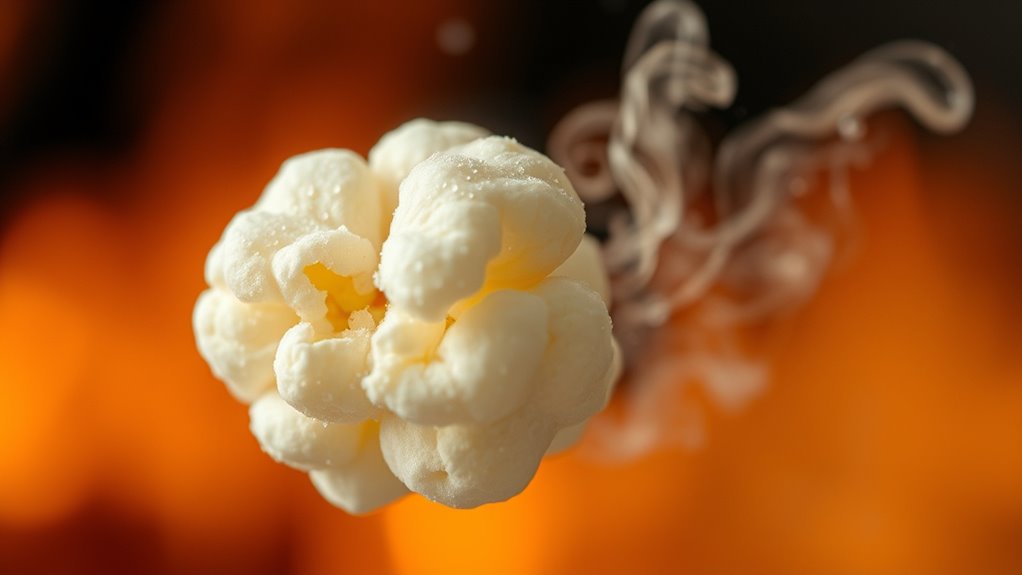
The key variables that influence popcorn expansion include the physical properties of the kernel, such as hardness, pericarp strength, and size, as well as the starch content and composition.
Harder kernels burst more effectively when heated, producing higher expansion volumes. The pericarp must be strong enough to contain internal pressure until popping; thicker pericarps generally result in better expansion. Variations in pericarp thickness and toughness among popcorn types affect popping performance.
Kernels with higher starch content tend to expand more, as gelatinized starch allows the interior to become pliable and expand upon rupture. Larger kernels typically have greater potential for expansion.
Additionally, factors like kernel shape, position on the ear, and uniform size influence consistency and overall popping quality.
The Role of Moisture Content and Temperature
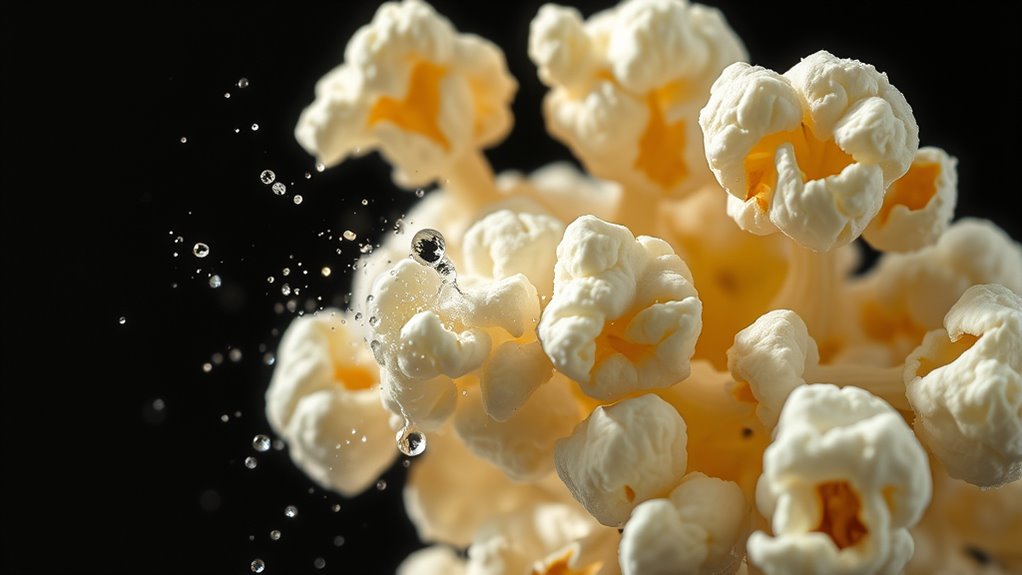
Moisture content and temperature are critical factors that directly influence popcorn’s popping performance. You want about 13.5% moisture inside each kernel, which creates enough steam pressure for a good pop. If moisture exceeds 20%, the pops become louder but may behave unpredictably. Higher moisture levels also mean more moisture loss during popping, affecting texture and expansion. The critical temperature for popping is around 180°C (356°F), with ideal results near 180-190°C. If you heat below this, popcorn won’t expand fully, and moisture loss increases. Temperature controls how quickly steam builds up, impacting kernel rupture. Adjusting temperature can compensate for slight moisture variations, ensuring consistent, fluffy popcorn. Proper moisture management and temperature control are essential for achieving the best popping quality.
Techniques and Methods for Popping Popcorn
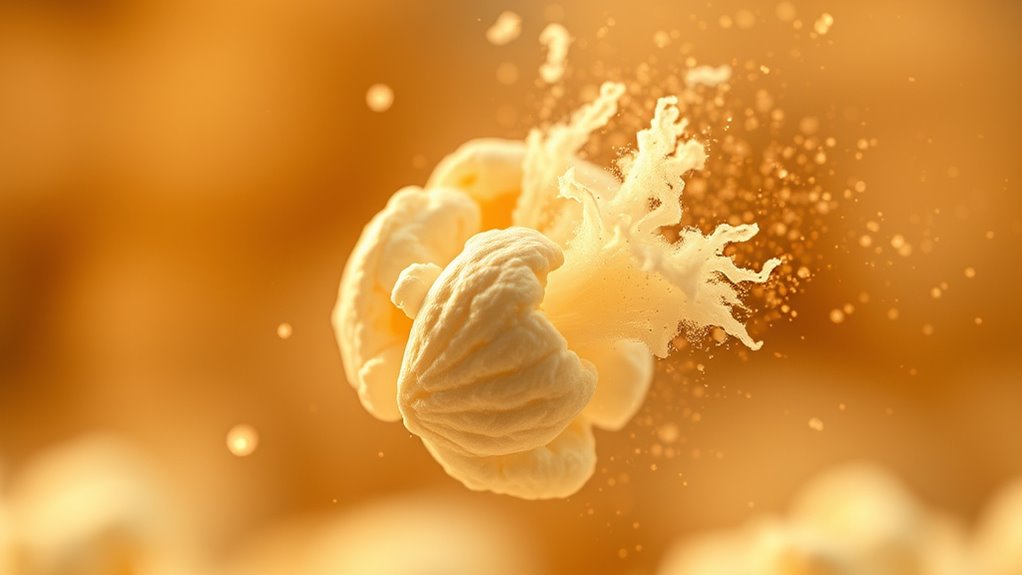
Different popcorn popping techniques vary in equipment, heat management, and oil use, each affecting the final texture and flavor.
With stovetop popping, you use about 2 tablespoons of oil per half cup of kernels, ensuring even coating and flavor adherence. Preheating the oil to around 350–400°F with test kernels helps prevent burning, while constant shaking or stirring promotes uniform heat and reduces scorching. Steam-release lids prevent sogginess by venting excess moisture, maintaining crispness.
The Whirley Pop features a built-in stirring crank and lightweight aluminum construction, reducing popping time and unpopped kernels.
Air-popping uses hot air circulation, producing low-calorie popcorn without oil but requiring post-popping seasoning.
Microwave techniques, like paper bags or specialized bowls, offer quick, oil-free options, while specialty methods like cast-iron pans or electric machines automate and optimize heat and stirring.
Cultural and Industry Significance of Popcorn
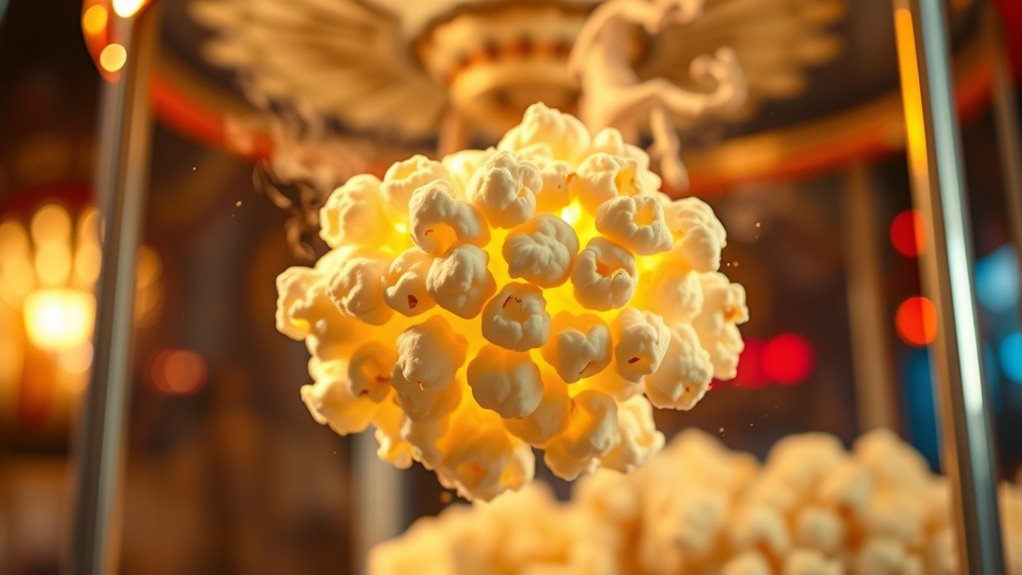
Popcorn holds a deep cultural and historical significance that extends far beyond its role as a simple snack. Indigenous societies, like the Aztecs, valued popcorn for religious ceremonies, decorating clothing and honoring gods such as Tlaloc. They believed the popping sound symbolized spirits or life itself, linking popcorn to beliefs about rebirth and transformation.
Archaeological finds show popcorn kernels from ancient burial sites, preserved for over a thousand years, highlighting its cultural importance. When European explorers encountered popcorn in the Americas, they brought it back to Europe, spreading its fame.
Over time, popcorn evolved into a popular treat at fairs, theaters, and social gatherings, becoming an icon of resilience and comfort. Today, popcorn’s cultural roots remain deeply embedded in history, tradition, and industry.
Frequently Asked Questions
Why Do Some Popcorn Kernels Not Pop Even With Proper Heating?
You might wonder why some popcorn kernels don’t pop even when you heat them properly. It’s often because the hull isn’t intact, letting steam escape and preventing enough pressure buildup.
Additionally, if the kernel’s moisture is too low or too high, it won’t generate the right steam pressure. Storage issues or uneven heating can also cause kernels to remain unpopped, despite reaching the right temperature.
How Does Salt Affect the Popping Process Beyond Flavor Enhancement?
Salt doesn’t affect the popping process itself; it mainly influences kernel toughness when added before popping. If you add salt beforehand, it can make kernels tougher, which might hinder popping.
However, adding salt after popping won’t change the texture or popping efficiency. So, for best results, add salt after the popcorn is ready, enhancing flavor without interfering with the popping mechanism.
What Is the Ideal Moisture Level for Maximum Popcorn Expansion?
You want to know the ideal moisture level for maximum popcorn expansion. Keep the moisture content between 13% and 14.5%, with around 13.5% being *preferable*.
At this range, enough steam builds up inside the kernel for a full, fluffy pop. Too dry, and you’ll get many unpopped kernels; too moist, and the popcorn becomes soggy and chewy.
Maintaining this balance *guarantees* your popcorn pops perfectly every time.
Can Different Kernel Colors Influence Popping Quality or Flavor?
You might think kernel color just affects appearance, but it actually influences popping quality and flavor. Different colors, like black, purple, or red, are linked to unique antioxidant levels that subtly alter taste and texture.
For example, purple popcorn offers a sweet, nutty flavor, while black varieties tend to be smaller and tender with a naturally sweet note. So, your choice of kernel color can enhance both flavor and popping performance.
How Do Commercial Popcorn Machines Optimize Popping Efficiency?
You want to maximize popping efficiency, so commercial popcorn machines use durable, heat-conductive materials like stainless steel to guarantee even heat distribution.
They feature precise temperature controls, automated stirring, and IoT sensors that monitor conditions in real-time.
Larger kettle capacities and adjustable settings help match batch sizes, while energy-saving tech reduces waste.
All these features work together to produce consistent, high-quality popcorn with minimal unpopped kernels.
Conclusion
Understanding the chemistry behind popcorn popping is like revealing a secret dance inside each kernel. As heat and moisture work together, they create a mesmerizing transformation—turning simple kernels into fluffy, delicious treats. When you watch popcorn pop, you’re witnessing science in action, a enthralling display as powerful as a thunderclap. So next time you enjoy a bowl, remember the incredible chemistry that makes every pop a tiny miracle.
